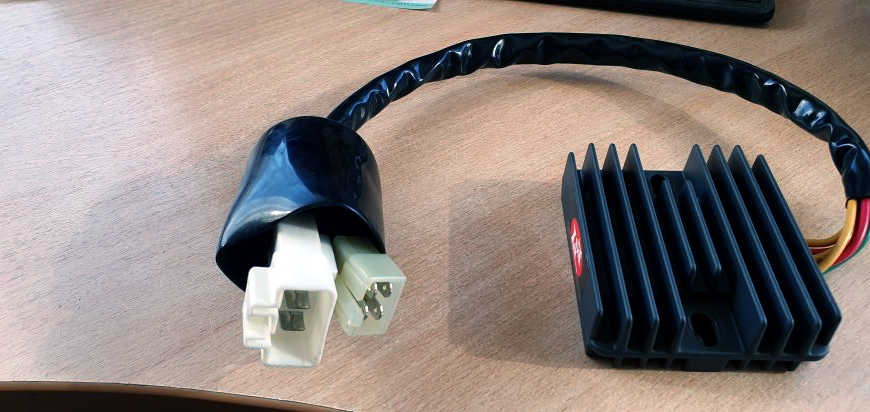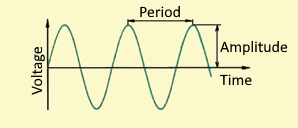Diagnosing and fixing electrical problems on a motorcycle can be quite an intimidating task at first. However, once you get a quick rundown on what each component does and how it could go bad, then fixing electrical problems becomes quite fun.
Luckily, most motorcycle charging system components are pretty simple, including the rectifier – which is the main topic of this article.
But what is a motorcycle rectifier and what does it do? What are the symptoms of a bad rectifier and how do you test it? If you’re looking for quick answers to these questions, then stick around as we will cover the basics of motorcycle rectifiers.
What is a Motorcycle Rectifier & What Does it Do?

The motorcycle’s rectifier is this silver/black aluminum box with cooling fins. The rectifier converts alternating current (AC) from the stator into direct current (DC). The process of converting AC to DC is called Rectification, hence the name of the component. However, the rectifier is almost always paired with a voltage regulator and is actually called the Rectifier-Regulator.
That’s right, the same silver/black aluminum box with cooling fins that we call the Rectifier-Regulator converts AC to DC and regulates the alternator’s voltage.
Why Does a Motorcycle Need a Rectifier?
Most motorcycles, including ATVs and UTVs, use a 3-phase AC generator to produce electrical energy and to charge the battery. The 3-phase AC generator is also commonly referred to as the alternator in the car industry, since it produces alternating current.
However, both cars and motorcycles require DC (Direct Current) and not the AC that the generator outputs. This is where the rectifier comes into play.

The rectifier takes alternating current (seen above) and converts it into direct current, which is what the motorcycle needs to run.

It does that by using a full-bridge diode rectifier to convert the positive and negative peaks into positive bumps. Since the rectifier is almost always paired with the voltage regulator, those positive bumps are converted into the clean and steady ~14.5 VDC (Volts Direct Current) by the voltage regulator.
Bad Rectifier Symptoms
Remember, the rectifier is always paired with a voltage regulator on motorcycles made in the 80s and up. Once the rectifier portion of the rectifier-regulator combo goes out, then the AC voltage will get into the electrical system and cause weird glitches with the lights, mostly.
If the regulator portion fails, then your motorcycle’s battery will be overcharged, which is very dangerous.
- Dim Headlights – can be also caused by a bad stator or a bad battery
- Erratic Meter Readings – failed rectifier can cause weird glitches with the bike’s electronics
Engine Runs Rough at Higher RPMs – the charging system plays a big part in how the engine runs - Loss of Power – the engine seems more sluggish
- Frequent Dead Battery – a failed voltage regulator can damage the battery and even make it explode
- Overcharging – this is a tell tale sign of a failed voltage regulator inside the rectifier-regulator box
- Undercharging – can also be caused by a bad stator or battery
How To Test a Rectifier on a Motorcycle
As can probably tell by now, it’s very difficult to determine whether the rectifier-regulator is going bad or is there something else that’s gone bad. Because of that, the best way to diagnose a bad rectifier-regulator is by using a multimeter.
Unfortunately, some rectifier-regulators are packed with extra electronics that can make testing them using a multimeter impossible. To get around that, you can use the elimination method.
With the elimination method, you should make sure that the battery is good, that the stator is good, and that the wiring from the stator to the rectifier-regulator and to the battery is good. Basically, make sure that everything else in the charging system but the rectifier-regulator is working as it should.
If everything else is ok, then the only part left out is the rectifier-regulator and thus it needs to be replaced. This is not a completely foolproof way of doing it, but it’s accurate 99% of the time if you thoroughly check everything.
But before you do any checks, first check the battery voltage while the engine is running. If the battery is being overcharged (voltage above 15.5 depending on the model), then the voltage regulator side of the rectifier-regulator has failed. Since the voltage regulator is always paired with the rectifier, replacing it will take care of any rectifier problems automatically.
Forward/Reverse Bias Test
To test the rectifier side of the rectifier-regulator, you will need a multimeter with a diode function.
This test is better explained via a video, so here’s a great How-To by Partzilla.
Will a Motorcycle Start With a Bad Rectifier?
Yes, a motorcycle will start and run with a bad rectifier.
With that said, the engine will run rough at higher RPMs or even at idle in some cases. Your instrument cluster might start glitching out or stop working completely.
Letting the engine run with a bad rectifier will cause serious damage to the battery if the voltage regulator side has failed.
Final Thoughts
Hopefully, this article helped you understand what is a motorcycle rectifier and what role it plays in the motorcycle’s charging system.
Do not forget that the rectifier is always paired with a voltage regulator – they’re in the same aluminum box with cooling fins.
Diagnosing a bad rectifier-regulator can be annoying and difficult, therefore I prefer the elimination method. Whichever you choose, make sure to fix your motorcycle’s charging system ASAP to minimize damage to other critical components.
Jake is the site’s primary contributor.
Motorcycles and automotive repair have been a big part of his family for generations, therefore it’s only natural that he decided to become a heavy-duty diesel tech.
Outside of work, you’ll find Jake restoring and riding rare street bikes and ATVs.